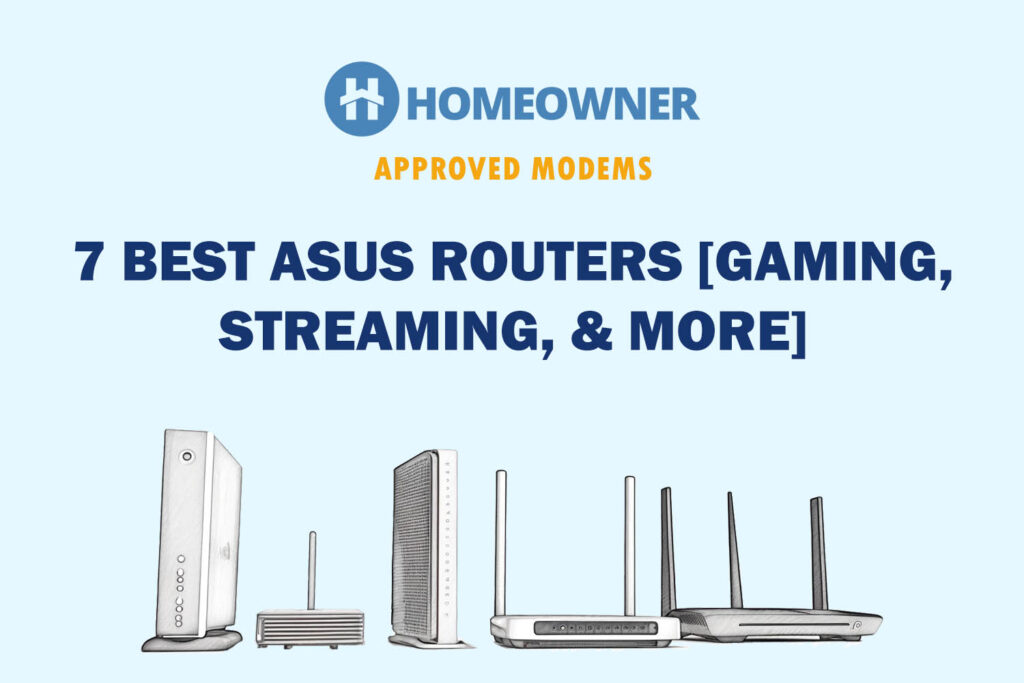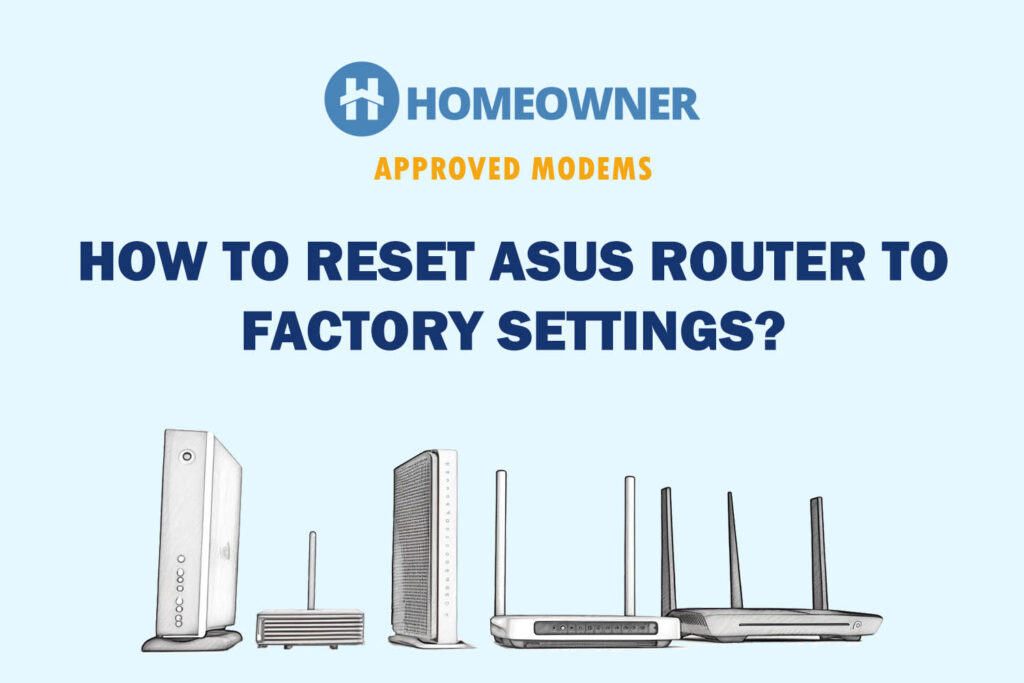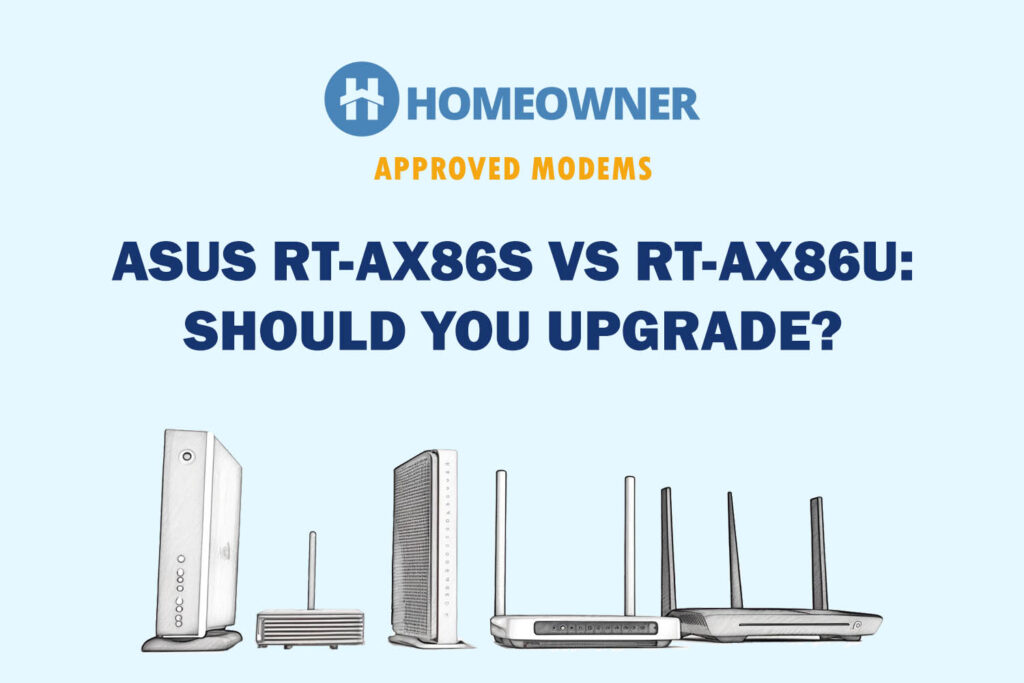If you're looking for a Wi-Fi 7 router, take a look at the ASUS RT-BE88U. It’s a dual-band model with dual 10G ports, support for AiMesh, and more wired ports than most home routers offer. It’s designed for homes with a lot of devices and people who want strong performance across both wired and wireless connections.
Pros
- Very fast wired speeds
- Strong, steady WiFi
- Lots of ports, including 10G and 2.5G
- Easy to use app
- Great security tools, no extra cost
- Handles many devices at once
Cons
- No 6 GHz band
- USB speeds could be better
- Some settings need a computer
I tested it in a real home setup to see how it handles daily use. That included setup, speed tests, network stability, and features like VPN, parental controls, and guest networks.
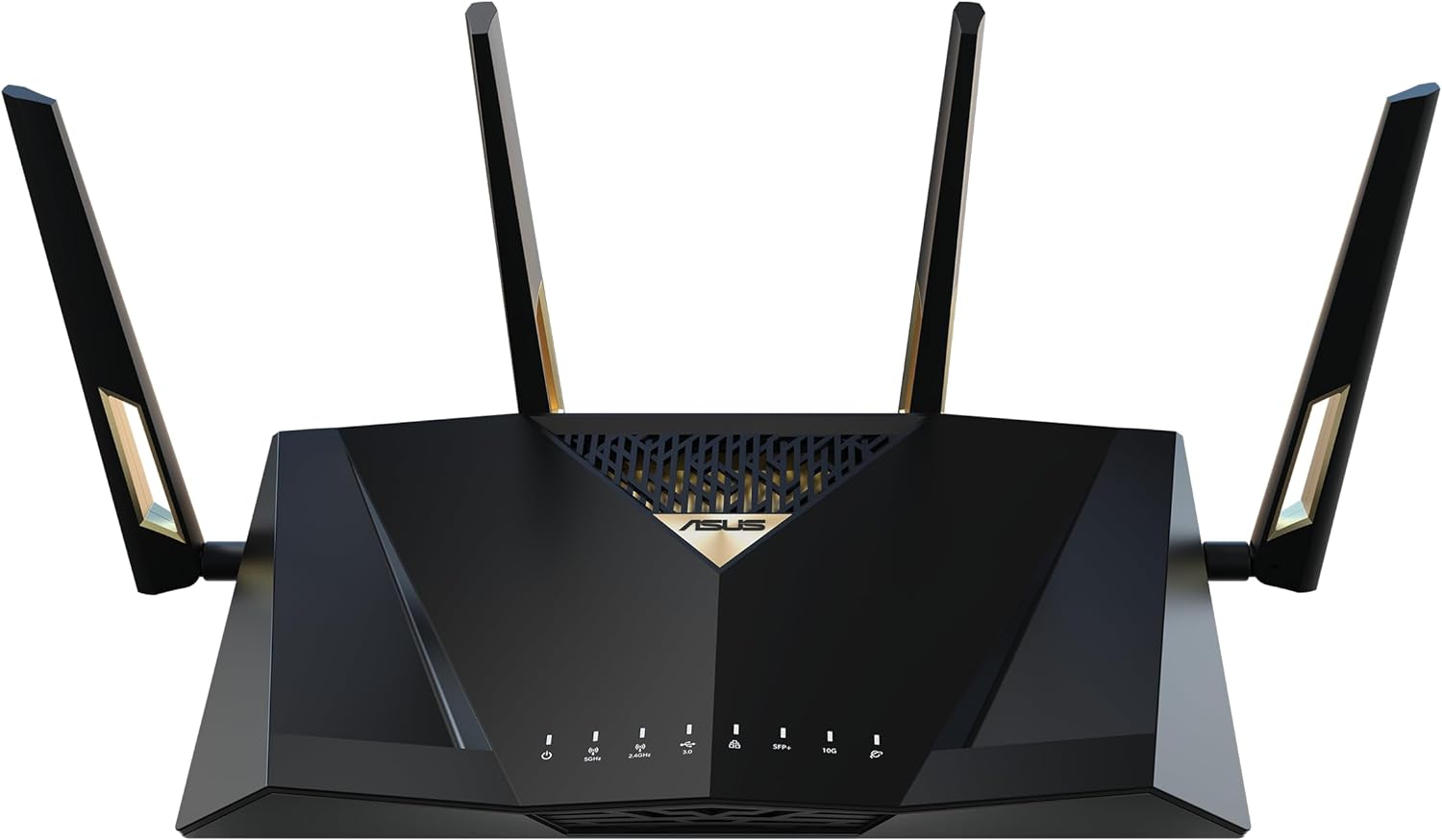
- WiFi 7 up to 7200 Mbps
- 10G SFP+ and 10G WAN/LAN
- USB port supports 4G/5G tethering
- Quad-core 2.6GHz CPU
- 5 SSIDs with Guest Network Pro
- AiProtection Pro and VPN support
- AiMesh whole-home networking
RT-BE88U Specifications
| Feature | Details |
|---|---|
| Wireless Standard | WiFi 7 (802.11be), also supports 802.11a/b/g/n/ac/ax |
| Frequency Bands | Dual-band (2.4 GHz + 5 GHz) |
| Max WiFi Speed | Up to 7200 Mbps (1376 Mbps + 5764 Mbps) |
| Antennas | 4 external detachable antennas (4×4:4) |
| Processor | Quad-core 2.6 GHz |
| RAM | 2 GB |
| Flash Storage | 256 MB |
| Wired Ports | 1x 10G SFP+ WAN/LAN, 1x 10G WAN/LAN, 1x 2.5G WAN/LAN, 3x 2.5G LAN, 4x 1G LAN |
| USB Port | 1x USB 3.2 Gen 1 |
| Combined Wired Capacity | Up to 34 Gbps WAN/LAN total |
| AiMesh Support | Yes (Router or Node) |
| Guest Networks | Up to 5 SSIDs with Guest Network Pro |
| Security | AiProtection Pro (Trend Micro) |
| VPN Support | WireGuard, OpenVPN, IPSec, PPTP, VPN Fusion |
| Parental Controls | Web/App Filters, Time Scheduling, Safe Browsing |
| Dimensions | 300 x 188 x 60.5 mm |
| Weight | 1060 g |
The ASUS RT-BE88U is designed to support fast home networks with high device counts, heavy wired traffic, and modern WiFi 7 features. This model includes upgrades across almost every part of its hardware—from wireless speed and port capacity to processing power and software options.
Keep in mind that it’s dual-band, not tri-band, which may matter to some users. However, the performance is surprisingly impressive.
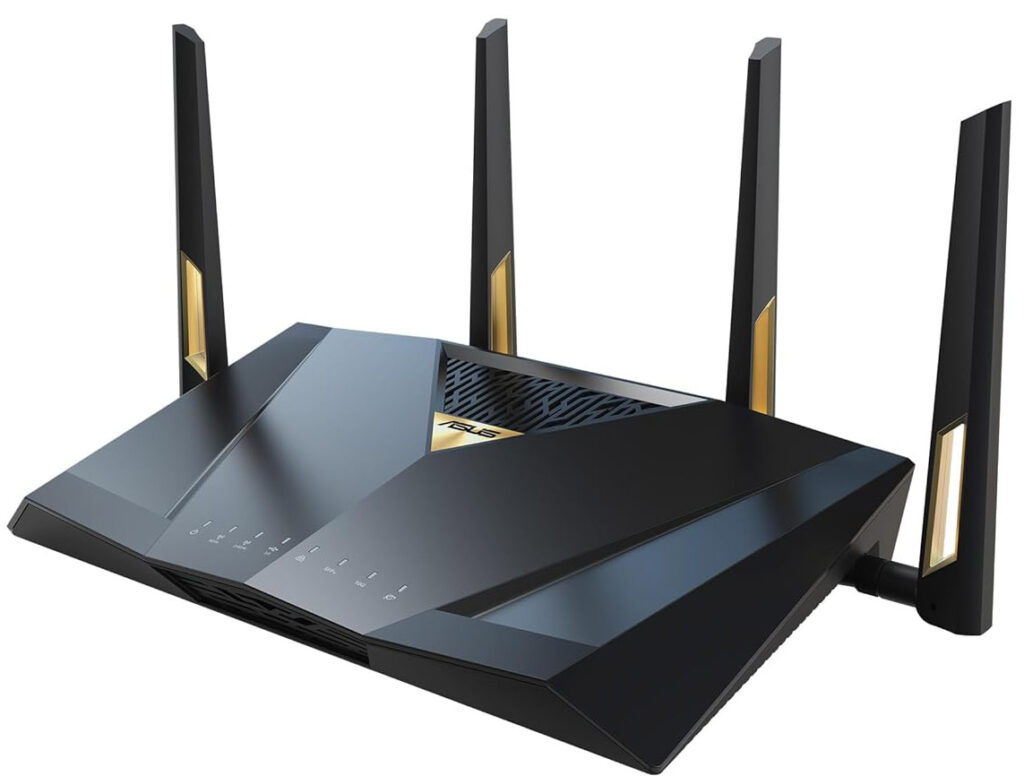
Connectivity
This router supports WiFi 7 (802.11be). It includes features like 4K-QAM for faster data transmission and Multi-Link Operation (MLO), which lets devices connect across both 2.4 GHz and 5 GHz bands at the same time. The total wireless bandwidth reaches up to 7200 Mbps: up to 1376 Mbps on 2.4 GHz and 5764 Mbps on 5 GHz.
It uses four external antennas, each detachable, with 4×4 MU-MIMO support on both bands. MU-MIMO lets the router talk to multiple devices at once, rather than switching between them one at a time. Beamforming is also included, which helps direct signal strength toward devices.
When it comes to wired connections, this router has more Ethernet capacity than most homes will need. In total, it offers nine wired LAN ports and one WAN port—but several ports can be reassigned depending on your setup. It also supports WAN Aggregation, LAN Aggregation, and Dual WAN. The combined wired throughput tops out at 34 Gbps across WAN and LAN.
The RT-BE88U includes an SFP+ port, and there’s a single USB 3.2 Gen 1 port on the back. It can be used for external storage, file sharing, printer connections, or tethering a 4G/5G mobile device for backup internet.
Software

This model runs ASUS’s standard router firmware, which includes:
- AiMesh support (can be used as a primary router or mesh node)
- Guest Network Pro with support for up to 5 SSIDs
- Adaptive and Traditional QoS
- VPN Fusion, WireGuard, OpenVPN, and IPSec support
- AiProtection Pro powered by Trend Micro (no subscription needed)
- Web and app filters, Safe Browsing, and parental time schedules
- Traffic monitoring and analysis tools
The router supports up to 64 parental control profiles and the same number of firewall rules. For advanced users, features like VLAN tagging, DDNS, IPv6, and port forwarding are also available.
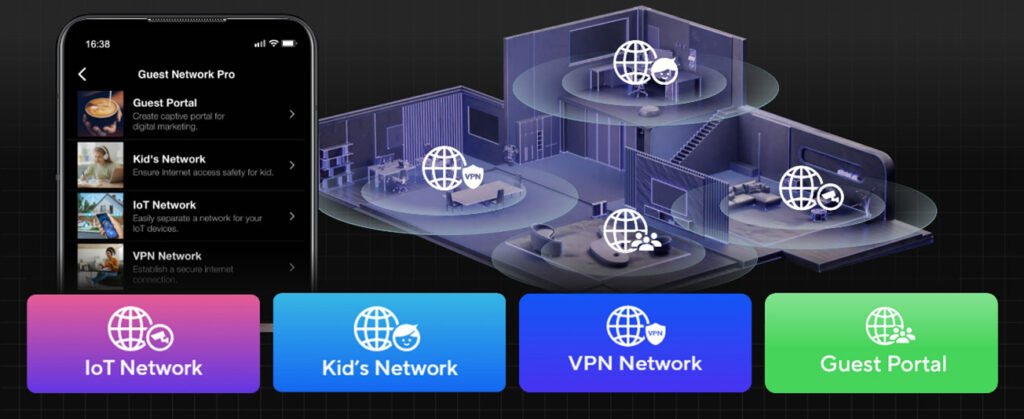
Wired vs Wireless Performance
To test real-world performance, I connected the RT-BE88U to a multi-gig internet service and ran it through a full day-to-day workload. That included large file transfers over the local network, streaming 4K video, downloading games, hosting a NAS, and keeping smart home devices connected across several rooms.
Wired Performance
Wired Performance
| Feature | Result |
|---|---|
| 10G Port Speed | Over 8.5 Gbps with Cat6a to desktop and NAS |
| SFP+ Port Speed | Matches 10G port with fiber module |
| LAN Port Stability | No throttling or lag, even under heavy load |
| Port Switching | Quick and reliable |
| Link Aggregation | Works smoothly, combines bandwidth without issues |
Wired performance is one of the biggest strengths of this router. I tested the 10G Ethernet port using Cat6a cable connected to a desktop and NAS, and consistently saw transfer rates over 8.5 Gbps during large file copies. When I moved to the SFP+ port with a fiber module, speeds were just as fast. Even under heavy use, the router showed no signs of thermal throttling or lag. Port switching was quick, and all LAN ports delivered expected speeds.
This is the kind of setup that lets you run a high-speed NAS, cloud backup, or shared media library without delays. It also handled link aggregation smoothly during tests, allowing two devices to combine bandwidth without issues.
👉 Related reading: Best ASUS Routers in 2025 [Gaming, Streaming, & More]
Wireless Performance
| Feature | Result |
|---|---|
| Close Range Speed | 1.7 Gbps (phone), 1.6 Gbps (laptop) within 10 feet |
| Medium Range Speed | 1.2–1.4 Gbps at 20–30 feet, depending on obstructions |
| Multi-Device Use | Smooth 4K streaming, gaming, video calls, and file syncing |
| Browsing Experience | Fast and responsive |
| WiFi Features | 4K-QAM and Multi-Link Operation boost speed and stability |
On the wireless side, I tested the router using WiFi 6 and WiFi 6E devices, since most current devices still use those standards. In close range (within 10 feet), I got up to 1.7 Gbps on a phone and 1.6 Gbps on a laptop. Speeds dropped slightly at medium range (20–30 feet) to about 1.2–1.4 Gbps, depending on obstructions.
Streaming was smooth, even with multiple 4K streams playing across TVs and tablets. I tested mobile gaming, video conferencing, and file syncing at the same time with no noticeable slowdowns. Browsing was responsive, and high-bandwidth apps never struggled.
The router’s 4K-QAM and Multi-Link Operation features help squeeze more speed and stability out of dual-band WiFi. Devices that supported it could use both bands together for more consistent performance, especially under load.
Everyday Use

This router is great for streaming, browsing, online school, and smart home automation. It handled over 32 devices during testing with no sign of stress. File downloads, large backups, and remote access for a home server all worked as expected.
For gamers, the router includes a dedicated gaming LAN port and QoS tools to prioritize game traffic. In testing, I didn’t see any lag or spikes while playing online, even with background downloads running. The reduced ping over wired connections was consistent, and wireless latency was stable as well.
If you’re doing remote work, video conferencing, or transferring large files regularly, the RT-BE88U is more than capable. It keeps up with heavier workloads and doesn’t slow down under multiple active users. It also works well as the core of a smart home setup, with reliable device handling and support for multiple SSIDs for segmenting traffic.
👉 Related reading: Asus Router Lights: Explained & Fixes!
Internet Speed Tests (Google Fiber 1 Gig)
I tested the RT-BE88U with a Google Fiber 1 Gig plan to see how well it handled typical gigabit internet service. The goal was to check consistency across both wired and wireless connections in different parts of the house.
On a wired desktop using the 10G Ethernet port, I consistently saw 920–940 Mbps download and around 940 Mbps upload, which is close to the theoretical max for a 1 Gbps connection after overhead. Speeds were stable during peak hours, with no dips or spikes across multiple speed tests using Speedtest.net.
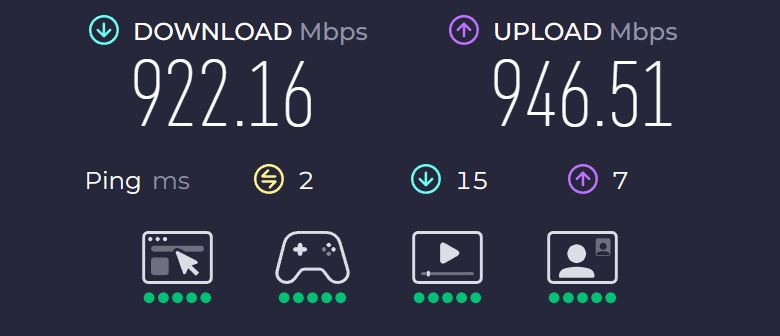
On WiFi, the results were also strong. Using a WiFi 6 laptop 10 feet from the router, I saw download speeds around 880–910 Mbps and upload speeds in the same range. Even in rooms farther from the router—up to 30 feet away through two walls—downloads held steady around 700–750 Mbps. That’s plenty for streaming 4K video, downloading large files, and cloud backups without interruption.
Phones using WiFi 6 (not 6E) also averaged around 850 Mbps down and 900 Mbps up in close range. Performance stayed consistent across devices, and I didn’t run into issues with bufferbloat or random slowdowns.
I also tested dual-band load balancing with a few modern devices supporting Multi-Link Operation. These were able to maintain slightly higher speeds when moving around the house, thanks to smoother band-switching and lower latency.
The router used the full capacity of the Google Fiber plan without any bottlenecks. For households using gigabit internet, this router is more than fast enough and has plenty of room for future upgrades if you move to a multi-gig service later.
👉 Related reading: Is 1000 Mbps fast?
Coverage and Capacity

I tested the RT-BE88U in a two-story, 2,100 square foot home built with drywall and interior brick walls. The router was placed centrally on the main floor, slightly elevated on a shelf. From there, I measured performance in every major room, including upstairs bedrooms, a garage, and an outdoor patio about 50 feet from the house.
Whole-Home Coverage
Coverage was consistent across all rooms. On the main floor, I saw full signal strength with WiFi speeds well above 800 Mbps in every direction. Upstairs, performance remained strong—above 700 Mbps in bedrooms directly above the router, and still over 600 Mbps in the far corners. Even in the basement, which often challenges routers due to flooring and insulation, I got over 400 Mbps, enough for streaming and online gaming.
Outdoor range was also better than average. On the back patio and around the yard (about 40–50 feet away), I maintained a usable connection with speeds around 200–300 Mbps depending on device orientation. That’s more than enough for outdoor video streaming, music, or video calls.
Device Handling
I connected over 35 devices during testing. This included smart plugs, video doorbells, two smart TVs, laptops, phones, tablets, a NAS, and a few gaming consoles. All devices maintained stable connections without disconnections or performance drops.
While transferring large files over wired and wireless, I monitored for congestion, and the router kept up without hesitation. Even with multiple video streams, gaming sessions, cloud backups, and video calls happening at the same time, I didn’t run into any noticeable lag or speed dips.
The 2.4 GHz band handled slower smart home gear without interfering with faster 5 GHz connections. I tested this by isolating a few smart switches and thermostats to one of the Guest Network Pro SSIDs and saw no instability.
For households with a mix of old and new devices, or setups with lots of background activity, the RT-BE88U has more than enough capacity. It delivers reliable performance without forcing users to micromanage device placement or band selection.
👉 Related reading: Best TV Streaming Services in 2025
Design and Connectivity
The RT-BE88U has a wide, low-profile design with four external, detachable antennas. The antennas are spaced evenly across the back and sides, and they can be adjusted or replaced if needed. The housing uses a ventilated plastic shell with a large internal heatsink visible through the side vents. It doesn’t use an internal fan, so it runs completely silent—even during extended high usage.
Physical Build
| Feature | Specification |
|---|---|
| Width | 300 mm |
| Depth | 188 mm |
| Height | 60.5 mm |
| Weight | 1060 grams (2.3 lbs) |
| Design | Large footprint, fanless with internal heatsink |
| Cooling | Passive (no fan), stays cool under load |
| Noise Level | Zero (fanless) |
| LED Indicators | Power, band activity, port usage, USB status, connectivity |
The RT-BE88U measures 300 mm wide, 188 mm deep, and 60.5 mm tall. It weighs 1060 grams (about 2.3 lbs). It’s a large router, and you’ll need shelf or desk space to accommodate the footprint and cables, especially if you’re using most of the Ethernet ports. It has a fanless design but includes a large internal heatsink for passive cooling, which keeps noise levels at zero while staying cool during long use.
LED indicators on the top panel show power, band activity, port usage, USB status, and overall connectivity. They’re visible but not overly bright, and they don’t cause a distraction in dark rooms.
Port Selection
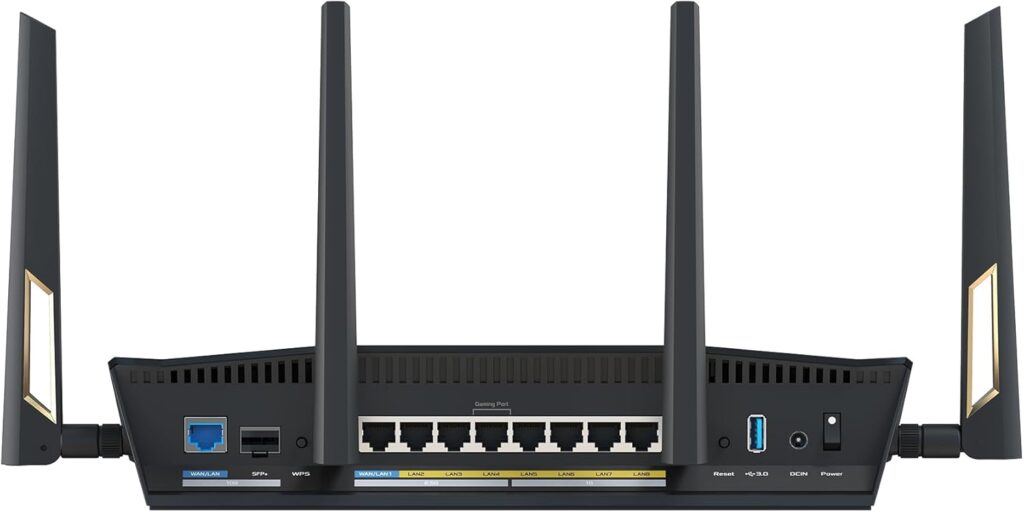
The port layout is one of the RT-BE88U’s biggest advantages. Every port is placed on the back of the router, keeping cable management simple. It includes:
- 1x 10G WAN/LAN port (RJ45)
- 1x 10G SFP+ port (fiber, WAN or LAN)
- 1x 2.5G WAN/LAN port
- 3x 2.5G LAN ports
- 4x 1G LAN ports
- 1x USB 3.2 Gen 1 Type-A port
You can reassign several ports as needed depending on your setup. I tested both the 10G Ethernet and 10G SFP+ ports with separate devices and had no trouble switching their function between WAN and LAN. The 2.5G and 1G ports performed as expected, even under high local traffic.
The included USB port is located on the back and works for file sharing, storage access, and LTE/5G tethering. I tested it with a USB 3.0 flash drive and saw transfer speeds around 120 MB/s write and 170 MB/s read—fine for basic backups and casual use.
There’s a physical power switch, a reset button, and WPS control—all located in the back.
Security Features
The RT-BE88U includes a full suite of built-in security tools designed for both casual users and advanced configurations. All features are managed through ASUS’s standard interface and do not require a subscription, which adds long-term value.
AiProtection Pro
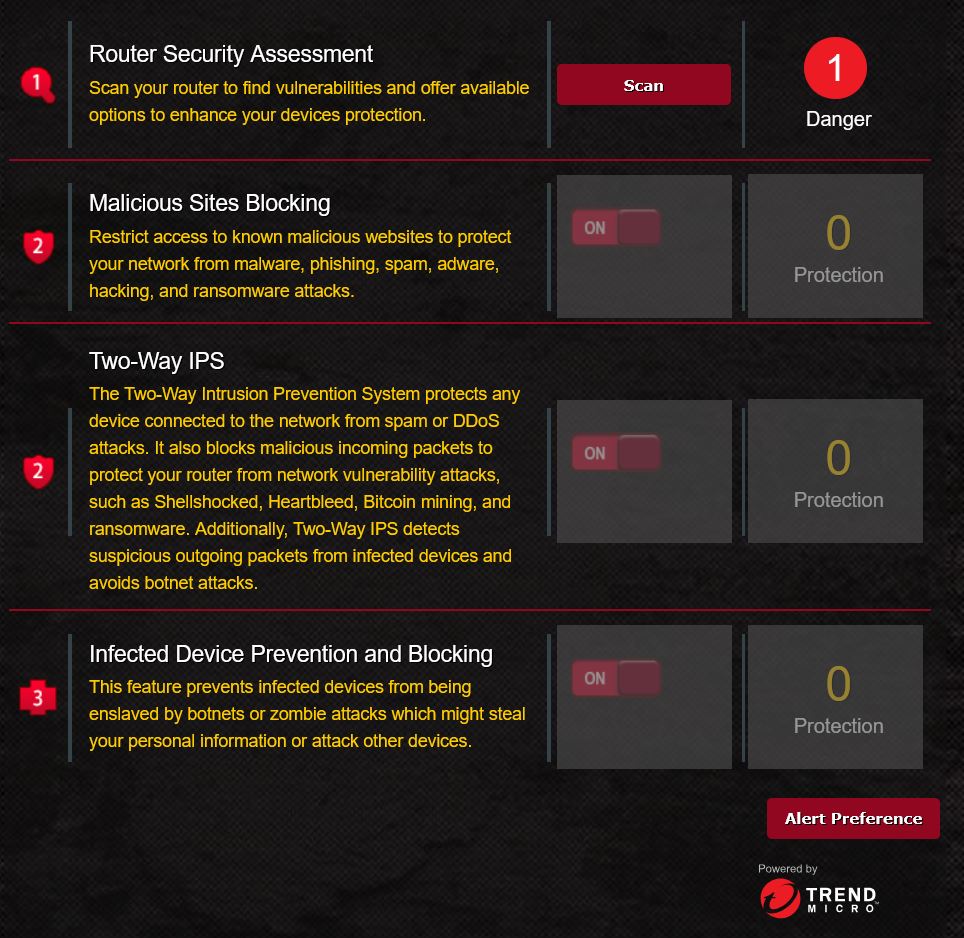
The router comes with AiProtection Pro, powered by Trend Micro. This includes:
- Real-time Network Protection: Blocks access to known malicious websites and prevents infected devices from communicating with external servers.
- Two-Way IPS (Intrusion Prevention System): Monitors incoming and outgoing traffic to detect suspicious patterns.
- Security Scanning: Checks your network setup and settings for potential vulnerabilities like open ports or weak passwords.
- Infected Device Blocking: Automatically isolates devices that show signs of infection or botnet behavior.
I tested the security scan tool multiple times during setup and device testing. It quickly flagged changes in settings that could affect security, such as disabling WPA3 or setting a wide-open guest network. You can fix issues directly from the alert screen, which keeps management simple.
👉 Related reading: Wyze DIY Security & Smart Home Review (Pros & Cons)
Parental Controls
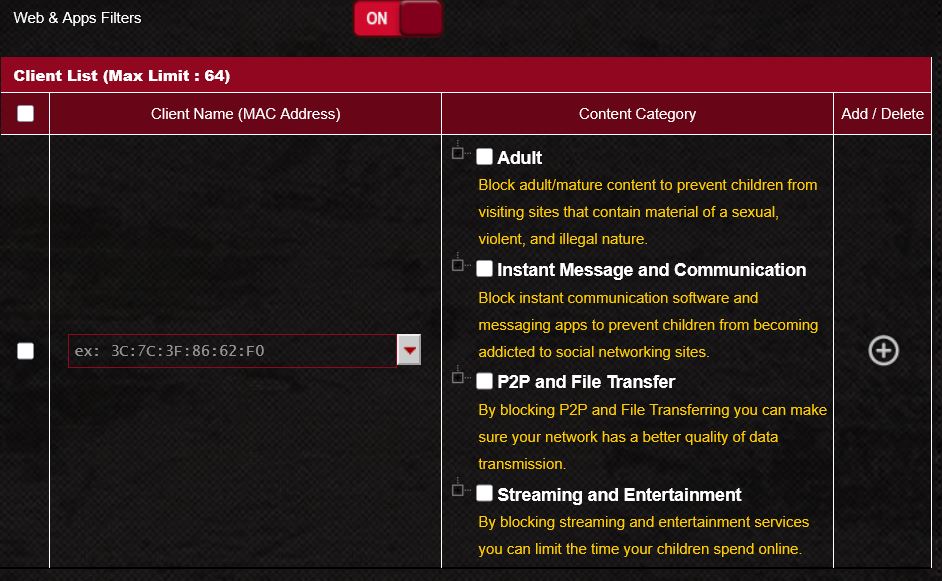
Parental control tools are accessible from both the app and browser interface. You can create up to 64 user profiles and assign filters for specific websites, apps, and categories (like social media or gaming). There's also a scheduling feature that lets you block access at certain times, useful for setting limits for kids or shared devices.
In testing, content filtering worked reliably across mobile and desktop devices. Safe Browsing also worked as expected, blocking known phishing or scam pages.
VPN and Encryption
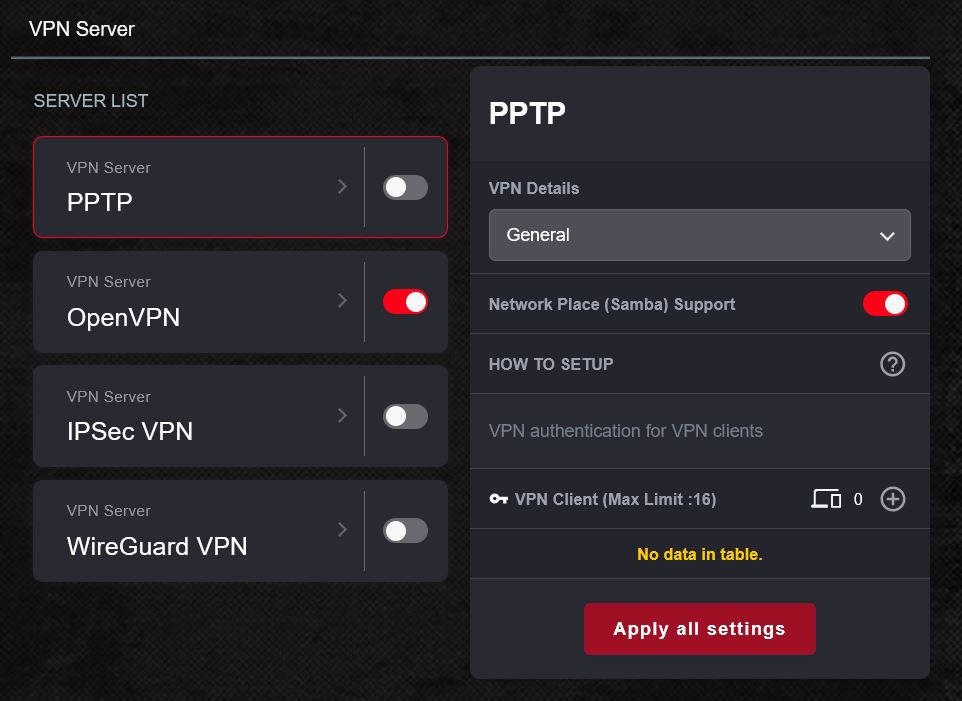
VPN support is strong. The RT-BE88U supports:
- VPN Fusion: Allows selected devices to use a VPN while others access the internet normally.
- WireGuard: Known for fast and lightweight performance.
- OpenVPN, IPSec, PPTP: For compatibility with various services.
- Site-to-Site VPN: For securely linking two separate networks.
You can run both VPN server and client modes simultaneously. I tested WireGuard and OpenVPN and saw stable performance with no drops. Setup was quick using the built-in templates, and speeds were good enough for remote work and private browsing.
Other Security Options
The router also supports WPA3 encryption, SSH access, firewall rule settings (up to 64 URL filters, 64 keyword filters), and DNS-over-TLS. You can disable remote access, block devices manually, and set up alerts for new device connections.
Overall, the RT-BE88U includes all the tools needed for secure home or small office use. Everything is accessible without a subscription, and the UI keeps settings easy to manage without losing control over advanced features.
👉 Related reading: Wired vs Wireless Security Cameras: Which Is Best?
Hardware and Internals

The RT-BE88U is built with high-performance components designed to handle heavy traffic across both wired and wireless networks. During testing, the hardware stayed responsive even when managing dozens of active connections and high-speed transfers.
Processor and Memory
At the core is a quad-core 2.6 GHz processor. This chip handles all routing, security, and device management functions. I tested it under stress by transferring large files, running multiple simultaneous video streams, and enabling both VPN and QoS features.
The router stayed stable the entire time with no noticeable slowdowns. Interface navigation remained smooth, even when traffic was high.
| Component | Specification |
|---|---|
| CPU | Quad-core 2.6 GHz processor |
| RAM | 2 GB |
| Flash Storage | 256 MB |
| Performance Notes | Smooth under heavy load, stable with VPN, QoS, and 30+ devices |
| OS Storage Use | Used for firmware, logs, and configuration backups; supports frequent updates |
It also comes with 2 GB of RAM, which is double what many routers in this category offer. This extra memory helps maintain performance when you’re using features like traffic monitoring, file sharing, or managing multiple VPN connections. I had over 30 devices online and didn’t see any performance drops related to memory limits.
For storage, the router includes 256 MB of flash memory. That space is used for the operating system, logs, and configuration backups. It's also enough to support frequent firmware updates and advanced logging tools without running into storage errors.
Passive Cooling
The router doesn’t use a fan. Instead, it relies on a large internal heatsink and full-length vents along the sides and bottom. During extended use—including 10G file transfers and long VPN sessions—the chassis remained warm but never hot. It stayed quieter than some earlier ASUS models that used small internal fans, which can be noisy over time.
Even in warmer environments, the passive cooling worked well. I tested it in a room with no direct airflow and high ambient temperatures, and the router performed without issues. No throttling, shutdowns, or random resets occurred, even under load.
Setup Process
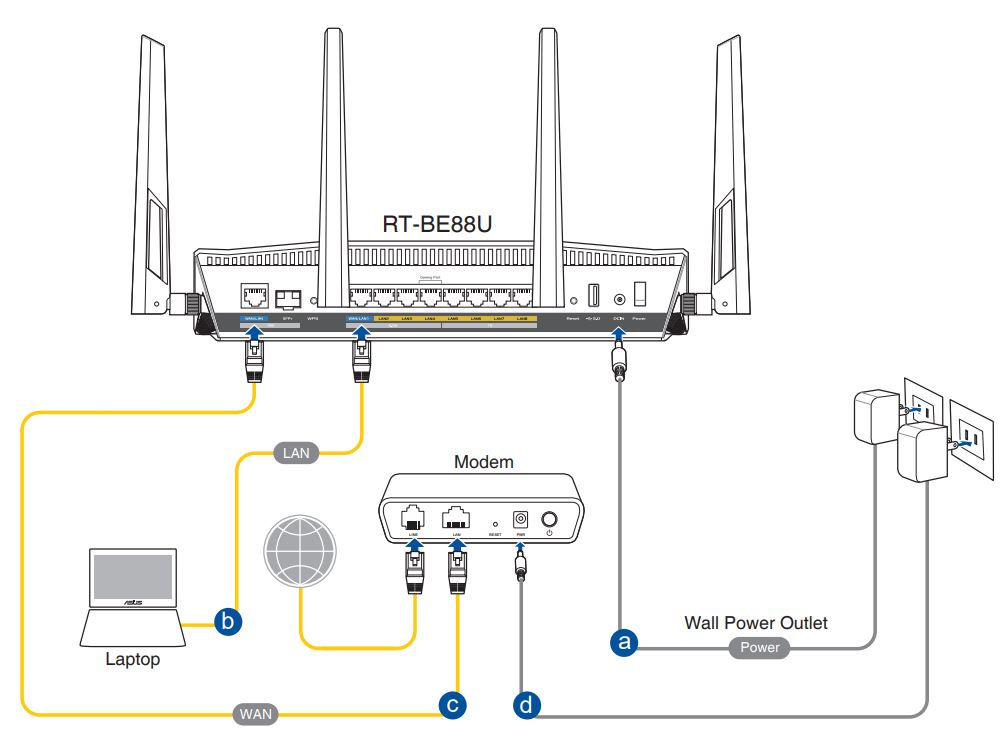
Getting the RT-BE88U up and running was mostly straightforward. I started by connecting it directly to a modem using the 10G WAN/LAN port, then powered it on and downloaded the ASUS Router app. The app walked through the initial steps—naming the network, setting a password, and checking the connection. That part took about 10 minutes.
You don’t have to use the app. I also went through the setup using the web interface on a laptop, which gives access to more advanced options like VLAN tagging, custom DNS, and manual port assignments. This was helpful when setting up my 2.5G WAN input and assigning LAN roles to different ports.
The firmware was up to date out of the box, but I checked manually and installed the latest version just to be sure. The process was smooth and didn’t require any file downloads or USB transfers. The router handled the update on its own through the interface.
I did run into a couple of small hiccups during setup. One test unit didn’t initially handshake properly with the modem until I rebooted both devices. After that, it connected without any further problems. I also noticed that the login page had issues loading in Firefox, so I switched to Chrome and it worked right away.
The ASUS Router app offers quick access to settings like AiMesh pairing, guest network controls, and traffic monitoring. It’s good for basic tweaks, but I found the web interface much better for full control, especially when setting up VPNs, assigning static IPs, or customizing QoS settings.
Overall, setup was easy enough for beginners but flexible enough for advanced users. If you’re used to ASUS firmware, the layout will feel familiar. If you’re new to it, there’s enough guidance built in to get through setup without needing outside help.
ASUS Router App
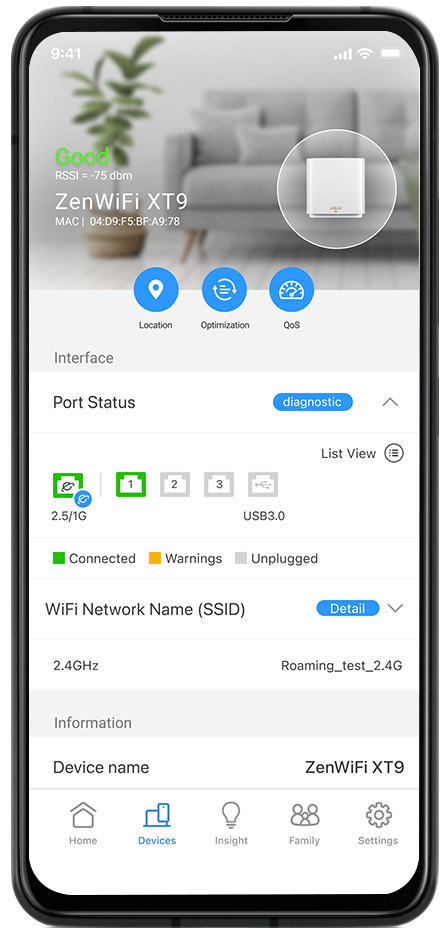
The ASUS Router app is a handy tool for setting up and managing your network right from your phone. It’s meant for anyone who doesn’t want to deal with logging into a browser every time they need to change a setting or check on connected devices. During testing, I used the app regularly alongside the web interface and found it helpful for everyday adjustments and monitoring.
What you can do with the app:
- Set up the router without using a computer
- View connected devices and manage access
- Turn on guest networks or pause the internet
- Run security scans using AiProtection
- Monitor bandwidth use in real time
- Set schedules and content filters with parental controls
- Get alerts for firmware updates and install them directly
- Add AiMesh nodes for expanded coverage
One of the most useful things about the app is how fast it makes routine tasks. If a new device connects, you can get a notification and decide whether to block or allow it. If someone needs guest WiFi access, you can enable it in seconds without touching the main network. You can also run a quick speed test to check your internet connection or see which devices are using the most bandwidth.
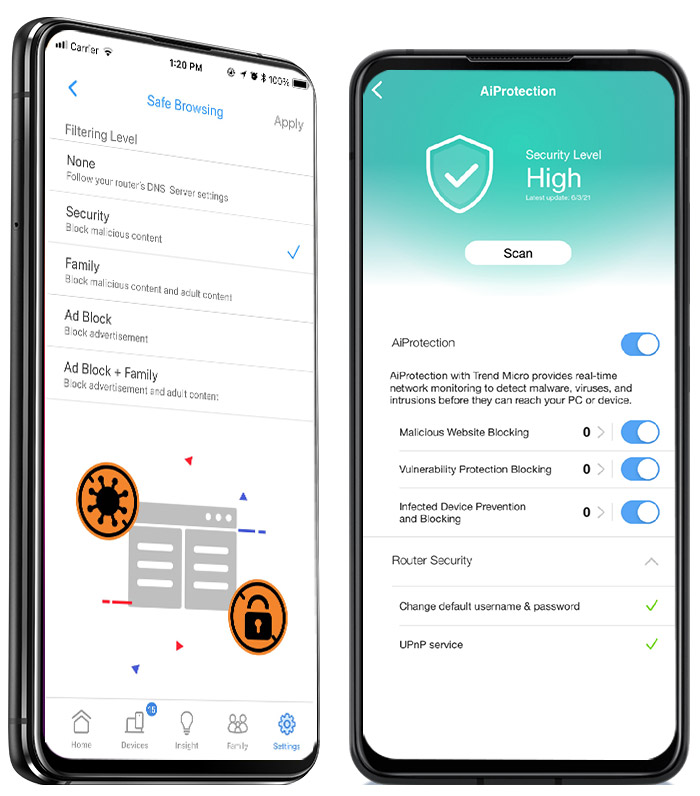
Parental controls are also easy to manage here. You can set up different profiles for kids, block websites or apps, and schedule offline times. It’s a simple way to keep certain devices offline during homework or bedtime, and changes apply instantly without needing a reboot or refresh.
The app doesn’t replace the full browser interface—some advanced tools like VPN Fusion and port configuration still require logging in on a computer. But for day-to-day use, the app covers a lot. It’s clean, fast, and makes it easier to manage your network without digging through menus. If you want quick access to important settings, the app is worth using.
👉 Related reading: Best Smart Home Devices – 2025 Shopping Guide
Wrapping Up
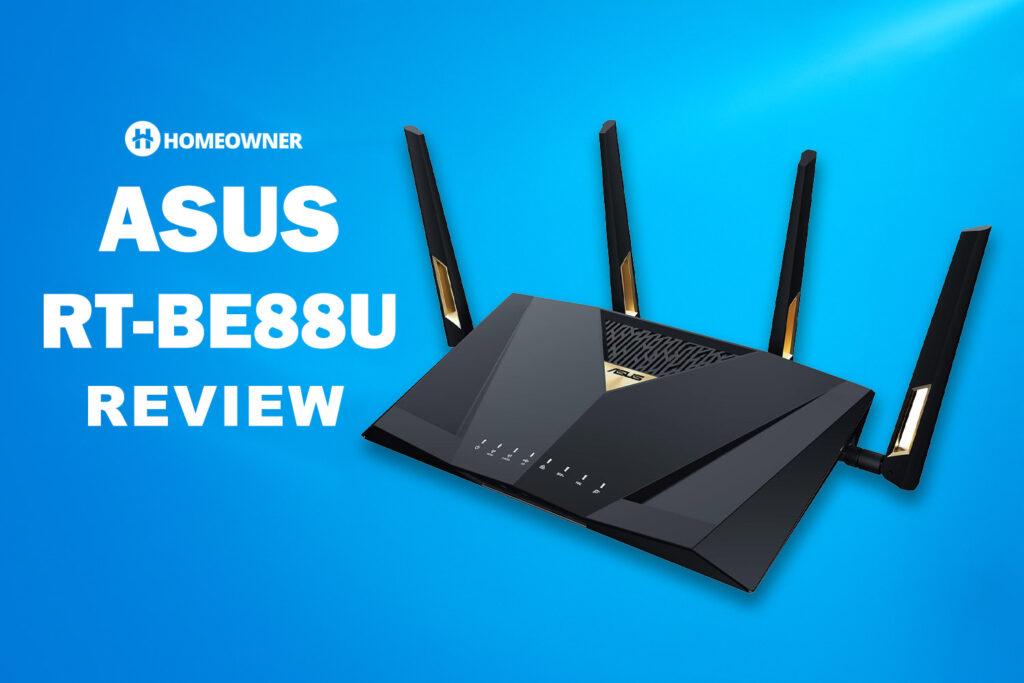
Let's take a closer look at what I liked and didn't like overall.
👍 What I Like
One of the best things about the RT-BE88U is the wired performance. Having both a 10G Ethernet port and a 10G SFP+ port gives you a lot of flexibility. I tested both with a desktop and NAS setup and saw consistently fast speeds—great for things like video editing, backups, and local file sharing. You also get multiple 2.5G ports, which helps when you have newer devices that support faster-than-gigabit speeds.
The router stayed stable the entire time. I ran it for over a week without restarting it, and it handled 30+ connected devices without a single disconnect or slowdown. That includes phones, tablets, laptops, TVs, smart home devices, and a NAS all running at once. Some routers slow down or get laggy under that kind of load, but this one didn’t.
I also liked how quiet it is. There’s no fan, so it runs completely silent. The heatsink and vent design kept things cool, even during large file transfers and heavy VPN traffic. I never noticed any overheating or performance drops tied to temperature.
The number of Ethernet ports is another major plus. A lot of routers only give you 4 LAN ports, but here you’re getting 9 in total. That’s enough to connect everything directly without needing an extra switch. Being able to assign roles to each port through the web interface adds even more control.
The ASUS Router app was better than expected. It’s not just for setup—you can manage parental controls, see which devices are using bandwidth, turn on guest networks, and even install firmware updates from your phone. For daily use, the app was fast and reliable.
I like how all the major security features come included. AiProtection Pro and Safe Browsing work out of the box, with no extra fees. It flagged unsafe settings during setup and helped monitor new device connections. Most routers this powerful charge extra for those tools.
👎 What I Don’t Like
The biggest downside is the missing 6 GHz band. While that doesn’t matter for everyone right now, some newer laptops and phones support 6 GHz and can benefit from the extra bandwidth and cleaner signal. For a WiFi 7 router, this is worth pointing out, especially if you're thinking long-term or already have WiFi 6E gear at home.
USB performance was another area that didn’t impress me. I tested a high-speed USB 3.0 flash drive and only got around 120 MB/s write and 170 MB/s read speeds. That’s okay for backups or sharing a few files, but it's not fast enough if you're hoping to use it like a mini-NAS. A front-facing USB port would’ve helped, too—plugging into the back isn’t ideal for frequent use.
Lastly, some of the advanced settings are locked to the browser. The app handles a lot, but if you want to use features like VPN Fusion, VLAN tagging, or custom port settings, you still have to log in on a computer. The setup process also ran into small issues, like one modem handshake failing until a manual reboot. None of this was a dealbreaker, but it adds a little friction during setup and configuration.
Final Thoughts
The ASUS RT-BE88U is a strong performer for homes that want high-speed wired connections, reliable WiFi, and full control over their network. In testing, it handled everything I threw at it—file transfers, streaming, gaming, smart home traffic—without lag or disconnects. The range was more than enough for a two-story house and even reached well into the yard.
If you don’t need tri-band WiFi or 6 GHz support, this router delivers excellent value. You get fast speeds, a ton of usable ports, and a full set of tools for security and customization. Whether you’re upgrading an older network or building around a multi-gig setup, the RT-BE88U has the hardware and features to keep up.

- WiFi 7 up to 7200 Mbps
- 10G SFP+ and 10G WAN/LAN
- USB port supports 4G/5G tethering
- Quad-core 2.6GHz CPU
- 5 SSIDs with Guest Network Pro
- AiProtection Pro and VPN support
- AiMesh whole-home networking
Continue reading:




